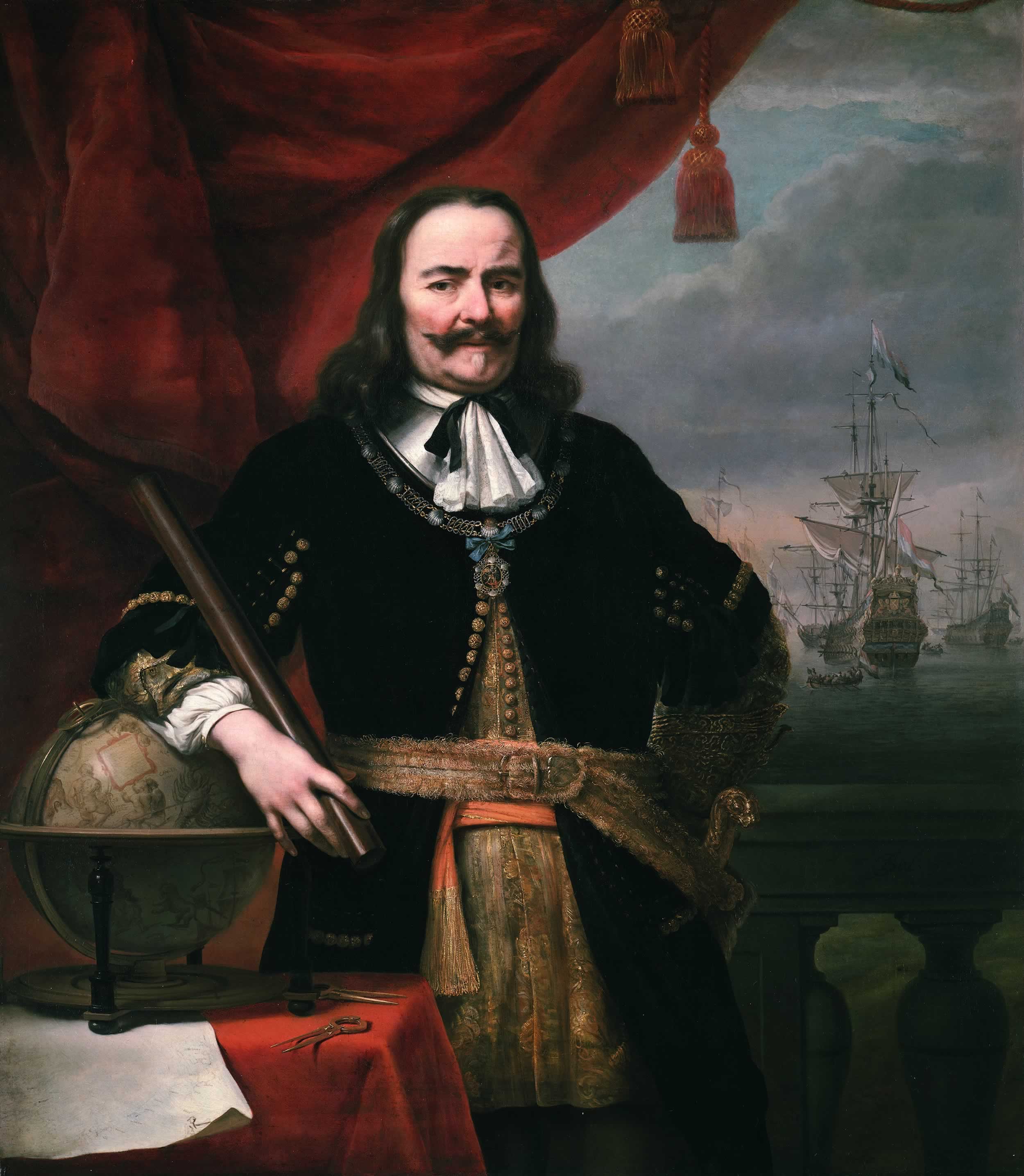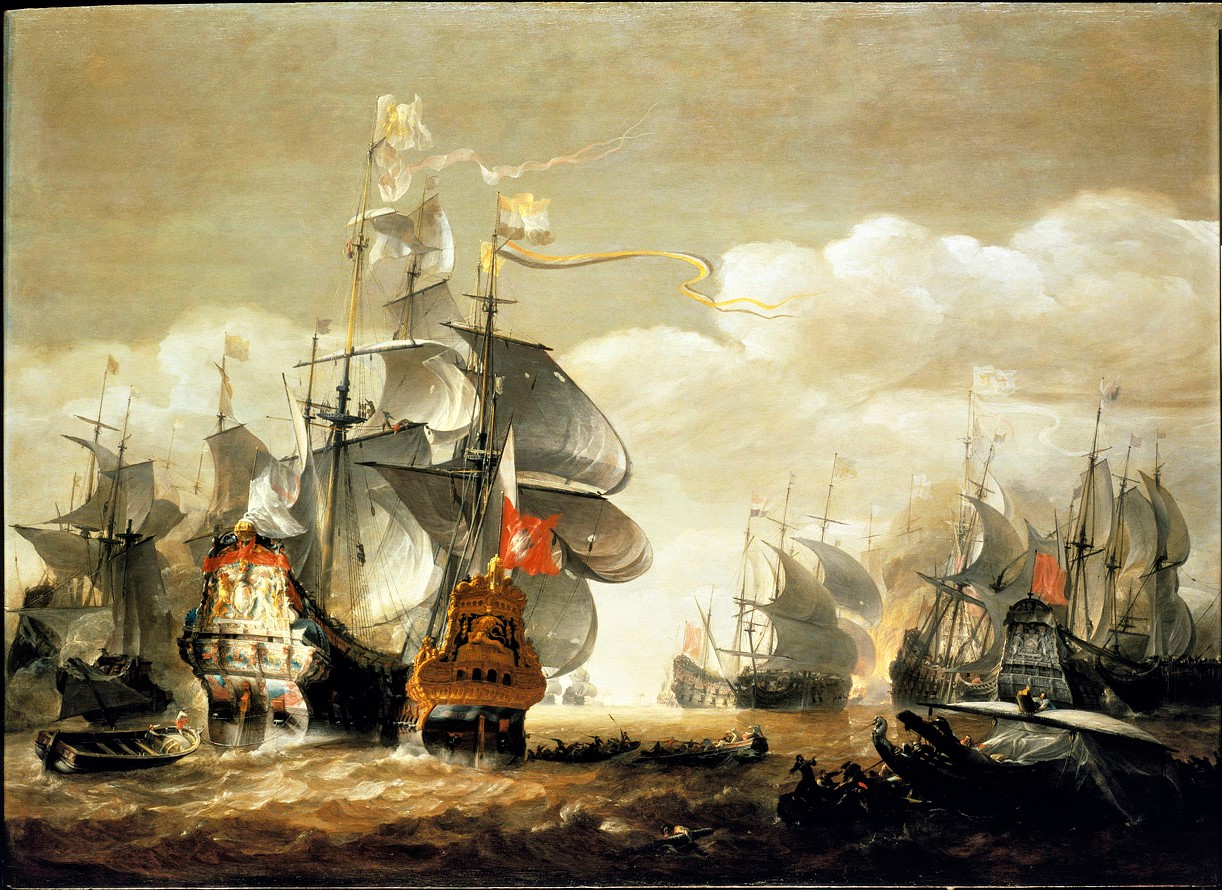|
Four Days Battle
The Four Days' Battle, also known as the Four Days' Fight in some English sources and as Vierdaagse Zeeslag in Dutch, was a naval battle of the Second Anglo-Dutch War. Fought from 1 June to 4 June 1666 in the Julian or Old Style calendar that was then used in England, in the southern North Sea, it began off the Flemish coast and ended near the English coast. It remains one of the longest naval engagements in history. Dutch accounts referred to its dates as 11 June to 14 June 1666 by using the New Style calendar. The Dutch inflicted significant damage on the English fleet, which lost ten ships in total, with over 1,000 men killed, including two vice-admirals, Sir Christopher Myngs and Sir William Berkeley, and almost 2,000 English were taken prisoner including a third vice-admiral, George Ayscue. Dutch losses were four ships destroyed by fire and over 1,550 men killed, including Lieutenant Admiral Cornelis Evertsen, Vice Admiral Abraham van der Hulst and Rear Admiral Frederik S ... [...More Info...] [...Related Items...] OR: [Wikipedia] [Google] [Baidu] |
Second Anglo-Dutch War
The Second Anglo-Dutch War or the Second Dutch War (4 March 1665 – 31 July 1667; nl, Tweede Engelse Oorlog "Second English War") was a conflict between England and the Dutch Republic partly for control over the seas and trade routes, where England tried to end the Dutch domination of world trade during a period of intense European commercial rivalry, but also as a result of political tensions. After initial English successes, the war ended in a Dutch victory. It was the second of a series of naval wars fought between the English and the Dutch in the 17th and 18th centuries. Background Anglo-Dutch relations Traditionally, many historians considered that the First and Second Anglo-Dutch Wars arose from commercial and maritime rivalry between England and the Netherlands. Although continuing commercial tensions formed the background to the second war, a group of ambitious English politicians and naval officers frustrated diplomatic efforts to reach any accommodation be ... [...More Info...] [...Related Items...] OR: [Wikipedia] [Google] [Baidu] |
North Sea
The North Sea lies between Great Britain, Norway, Denmark, Germany, the Netherlands and Belgium. An epeiric sea on the European continental shelf, it connects to the Atlantic Ocean through the English Channel in the south and the Norwegian Sea in the north. It is more than long and wide, covering . It hosts key north European shipping lanes and is a major fishery. The coast is a popular destination for recreation and tourism in bordering countries, and a rich source of energy resources, including wind and wave power. The North Sea has featured prominently in geopolitical and military affairs, particularly in Northern Europe, from the Middle Ages to the modern era. It was also important globally through the power northern Europeans projected worldwide during much of the Middle Ages and into the modern era. The North Sea was the centre of the Vikings' rise. The Hanseatic League, the Dutch Republic, and the British each sought to gain command of the North Sea and access ... [...More Info...] [...Related Items...] OR: [Wikipedia] [Google] [Baidu] |
Spanish Netherlands
Spanish Netherlands ( Spanish: Países Bajos Españoles; Dutch: Spaanse Nederlanden; French: Pays-Bas espagnols; German: Spanische Niederlande.) (historically in Spanish: ''Flandes'', the name "Flanders" was used as a '' pars pro toto'') was the Habsburg Netherlands ruled by the Spanish branch of the Habsburgs from 1556 to 1714. They were a collection of States of the Holy Roman Empire in the Low Countries held in personal union by the Spanish Crown (also called Habsburg Spain). This region comprised most of the modern states of Belgium and Luxembourg, as well as parts of northern France, the southern Netherlands, and western Germany with the capital being Brussels. The Army of Flanders was given the task of defending the territory. The Imperial fiefs of the former Burgundian Netherlands had been inherited by the Austrian House of Habsburg from the extinct House of Valois-Burgundy upon the death of Mary of Burgundy in 1482. The Seventeen Provinces formed the core of the Habs ... [...More Info...] [...Related Items...] OR: [Wikipedia] [Google] [Baidu] |
Louis XIV Of France
, house = Bourbon , father = Louis XIII , mother = Anne of Austria , birth_date = , birth_place = Château de Saint-Germain-en-Laye, Saint-Germain-en-Laye, France , death_date = , death_place = Palace of Versailles, Versailles, France , burial_date = 9 September 1715 , burial_place = Basilica of Saint-Denis , religion = Catholicism ( Gallican Rite) , signature = Louis XIV Signature.svg Louis XIV (Louis Dieudonné; 5 September 16381 September 1715), also known as Louis the Great () or the Sun King (), was King of France from 14 May 1643 until his death in 1715. His reign of 72 years and 110 days is the longest of any sovereign in history whose date is verifiable. Although Louis XIV's France was emblematic of the age of absolutism in Europe, the King surrounded himself with a variety of significant political, military, and cultural figures, such as Bossuet, Colbert, Le Brun, Le Nôtre, Lully, Mazarin, Molière, Racine, ... [...More Info...] [...Related Items...] OR: [Wikipedia] [Google] [Baidu] |
Battle Of Scheveningen
The Battle of Scheveningen (also known as the Battle of Ter Heijde) was the final naval battle of the First Anglo-Dutch War. It took place on 31 July 1653 (10 August on the Gregorian calendar), between the fleets of the Commonwealth of England and the United Provinces. The Dutch fleet suffered massive losses but achieved its immediate strategic goal of raising the Royal Navy blockade of the Dutch coast. Background After their victory at the Battle of the Gabbard in June 1653, the English fleet of 120 ships under General at Sea George Monck on his flagship ''Resolution'' blockaded the Dutch coast, capturing many merchant vessels. Royal Museums Greenwich. The Dutch economy began to collapse, with mass unemployment and a severe economic downturn affecting it. On 24 J ... [...More Info...] [...Related Items...] OR: [Wikipedia] [Google] [Baidu] |
Battle Of Lowestoft
The Battle of Lowestoft took place on during the Second Anglo-Dutch War. A fleet of more than a hundred ships of the United Provinces commanded by Lieutenant-Admiral Jacob van Wassenaer, Lord Obdam attacked an English fleet of equal size commanded by James, Duke of York forty miles east of the port of Lowestoft in Suffolk. Although it was a substantial English victory, the escape of the bulk of the Dutch fleet deprived England of the chance of ending the war quickly with a single decisive victory. As a result, the Dutch were able to make good their losses by building new and better-armed ships and improving their organisation and discipline. Their Dutch fleets would not be so badly organised or ill-disciplined in the remaining battles of this war and, in Obdam's replacement, Michiel de Ruyter, the Dutch had gained a superb tactician and leader for the remainder of the war. Background The Second Anglo-Dutch War resulted from long-standing commercial tensions between Englan ... [...More Info...] [...Related Items...] OR: [Wikipedia] [Google] [Baidu] |
Frigate
A frigate () is a type of warship. In different eras, the roles and capabilities of ships classified as frigates have varied somewhat. The name frigate in the 17th to early 18th centuries was given to any full-rigged ship built for speed and maneuverability, intended to be used in scouting, escort and patrol roles. The term was applied loosely to ships varying greatly in design. In the second quarter of the 18th century, the 'true frigate' was developed in France. This type of vessel was characterised by possessing only one armed deck, with an unarmed deck below it used for berthing the crew. Late in the 19th century (British and French prototypes were constructed in 1858), armoured frigates were developed as powerful ironclad warships, the term frigate was used because of their single gun deck. Later developments in ironclad ships rendered the frigate designation obsolete and the term fell out of favour. During the Second World War the name 'frigate' was reintroduced to ... [...More Info...] [...Related Items...] OR: [Wikipedia] [Google] [Baidu] |
Battle Of The Gabbard
The naval Battle of the Gabbard, also known as the Battle of Gabbard Bank, the Battle of the North Foreland or the Second Battle of Nieuwpoort took place on 2–3 June 1653 (12–13 June 1653 Gregorian calendar). during the First Anglo-Dutch War near the Gabbard shoal off the coast of Suffolk, England between fleets of the Commonwealth of England and the United Provinces. The battle The English fleet had 100 ships commanded by Generals at Sea George Monck and Richard Deane and Admirals John Lawson and William Penn. The Dutch had 98 ships under Lieutenant-Admiral Maarten Tromp and Vice-admiral Witte de With, divided in five squadrons. On 2 June 1653 the Dutch attacked but were beaten back because the English employed line-of-battle tactics, making the Dutch pay a high price for attempting to board. The Dutch fleet, consisting of lighter ships, was severely damaged and lost two ships. On 3 June the English were joined by Admiral Robert Blake, but Tromp decided to try agai ... [...More Info...] [...Related Items...] OR: [Wikipedia] [Google] [Baidu] |
Battle Of Portland
The naval Battle of Portland, or Three Days' Battle took place during 18–20 February 1653 (28 February – 2 March 1653 (Gregorian calendar)), during the First Anglo-Dutch War, when the fleet of the Commonwealth of England under General at Sea Robert Blake was attacked by a fleet of the Dutch Republic under Lieutenant-Admiral Maarten Tromp escorting merchant shipping through the English Channel. The battle failed to settle supremacy of the English Channel, although both sides claimed victory, and ultimate control over the Channel would only be decided at the Battle of the Gabbard which allowed the English to blockade the Dutch coast until the Battle of Scheveningen, where Admiral Maarten Tromp was killed in a firefight. Background The First Anglo-Dutch War was caused by friction between the two naval powers of the century, competing for strategic supremacy over the world's merchant routes. England and the United Provinces had always been 'natural allies' against the ... [...More Info...] [...Related Items...] OR: [Wikipedia] [Google] [Baidu] |
George Monck, 1st Duke Of Albemarle
George Monck, 1st Duke of Albemarle JP KG PC (6 December 1608 – 3 January 1670) was an English soldier, who fought on both sides during the Wars of the Three Kingdoms. A prominent military figure under the Commonwealth, his support was crucial to the Restoration of Charles II in 1660, who rewarded him with the title Duke of Albemarle and other senior positions. The younger son of an impoverished Devon landowner, Monck began his military career in 1625 and served in the Eighty Years' War until 1638, when he returned to England. Posted to Ireland as part of the army sent to suppress the Irish Rebellion of 1641, he quickly gained a reputation for efficiency and ruthlessness. After Charles I agreed to a truce with the Catholic Confederacy in September 1643, he was captured fighting for the Royalists at Nantwich in January 1644 and remained a prisoner for the next two years. Released in 1647, he was named Parliamentarian commander in Eastern Ulster, fought in Scotland u ... [...More Info...] [...Related Items...] OR: [Wikipedia] [Google] [Baidu] |
Robert Blake (admiral)
General at Sea Robert Blake (27 September 1598 – 17 August 1657) was an English naval officer who served as the Lord Warden of the Cinque Ports from 1656 to 1657. Blake is recognised as the chief founder of England's naval supremacy, a dominance subsequently inherited by the British Royal Navy well into the early 20th century.Greenwich Pageant , 18 July 1933 Despite this, due to deliberate attempts to expunge the Parliamentarians from historical records following the Stuart Restoration, Blake's achievements tend to remain unrecognized. Bla ... [...More Info...] [...Related Items...] OR: [Wikipedia] [Google] [Baidu] |








